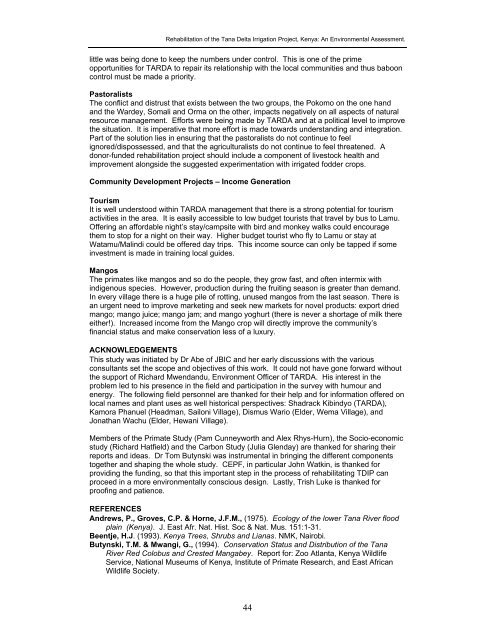Tana Delta Irrigation Project, Kenya: An Environmental Assessment
Tana Delta Irrigation Project, Kenya: An Environmental Assessment
Tana Delta Irrigation Project, Kenya: An Environmental Assessment
Create successful ePaper yourself
Turn your PDF publications into a flip-book with our unique Google optimized e-Paper software.
Rehabilitation of the <strong>Tana</strong> <strong>Delta</strong> <strong>Irrigation</strong> <strong>Project</strong>, <strong>Kenya</strong>: <strong>An</strong> <strong>Environmental</strong> <strong>Assessment</strong>.<br />
little was being done to keep the numbers under control. This is one of the prime<br />
opportunities for TARDA to repair its relationship with the local communities and thus baboon<br />
control must be made a priority.<br />
Pastoralists<br />
The conflict and distrust that exists between the two groups, the Pokomo on the one hand<br />
and the Wardey, Somali and Orma on the other, impacts negatively on all aspects of natural<br />
resource management. Efforts were being made by TARDA and at a political level to improve<br />
the situation. It is imperative that more effort is made towards understanding and integration.<br />
Part of the solution lies in ensuring that the pastoralists do not continue to feel<br />
ignored/dispossessed, and that the agriculturalists do not continue to feel threatened. A<br />
donor-funded rehabilitation project should include a component of livestock health and<br />
improvement alongside the suggested experimentation with irrigated fodder crops.<br />
Community Development <strong>Project</strong>s – Income Generation<br />
Tourism<br />
It is well understood within TARDA management that there is a strong potential for tourism<br />
activities in the area. It is easily accessible to low budget tourists that travel by bus to Lamu.<br />
Offering an affordable night’s stay/campsite with bird and monkey walks could encourage<br />
them to stop for a night on their way. Higher budget tourist who fly to Lamu or stay at<br />
Watamu/Malindi could be offered day trips. This income source can only be tapped if some<br />
investment is made in training local guides.<br />
Mangos<br />
The primates like mangos and so do the people, they grow fast, and often intermix with<br />
indigenous species. However, production during the fruiting season is greater than demand.<br />
In every village there is a huge pile of rotting, unused mangos from the last season. There is<br />
an urgent need to improve marketing and seek new markets for novel products: export dried<br />
mango; mango juice; mango jam; and mango yoghurt (there is never a shortage of milk there<br />
either!). Increased income from the Mango crop will directly improve the community’s<br />
financial status and make conservation less of a luxury.<br />
ACKNOWLEDGEMENTS<br />
This study was initiated by Dr Abe of JBIC and her early discussions with the various<br />
consultants set the scope and objectives of this work. It could not have gone forward without<br />
the support of Richard Mwendandu, Environment Officer of TARDA. His interest in the<br />
problem led to his presence in the field and participation in the survey with humour and<br />
energy. The following field personnel are thanked for their help and for information offered on<br />
local names and plant uses as well historical perspectives: Shadrack Kibindyo (TARDA),<br />
Kamora Phanuel (Headman, Sailoni Village), Dismus Wario (Elder, Wema Village), and<br />
Jonathan Wachu (Elder, Hewani Village).<br />
Members of the Primate Study (Pam Cunneyworth and Alex Rhys-Hurn), the Socio-economic<br />
study (Richard Hatfield) and the Carbon Study (Julia Glenday) are thanked for sharing their<br />
reports and ideas. Dr Tom Butynski was instrumental in bringing the different components<br />
together and shaping the whole study. CEPF, in particular John Watkin, is thanked for<br />
providing the funding, so that this important step in the process of rehabilitating TDIP can<br />
proceed in a more environmentally conscious design. Lastly, Trish Luke is thanked for<br />
proofing and patience.<br />
REFERENCES<br />
<strong>An</strong>drews, P., Groves, C.P. & Horne, J.F.M., (1975). Ecology of the lower <strong>Tana</strong> River flood<br />
plain (<strong>Kenya</strong>). J. East Afr. Nat. Hist. Soc & Nat. Mus. 151:1-31.<br />
Beentje, H.J. (1993). <strong>Kenya</strong> Trees, Shrubs and Lianas. NMK, Nairobi.<br />
Butynski, T.M. & Mwangi, G., (1994). Conservation Status and Distribution of the <strong>Tana</strong><br />
River Red Colobus and Crested Mangabey. Report for: Zoo Atlanta, <strong>Kenya</strong> Wildlife<br />
Service, National Museums of <strong>Kenya</strong>, Institute of Primate Research, and East African<br />
Wildlife Society.<br />
44

















